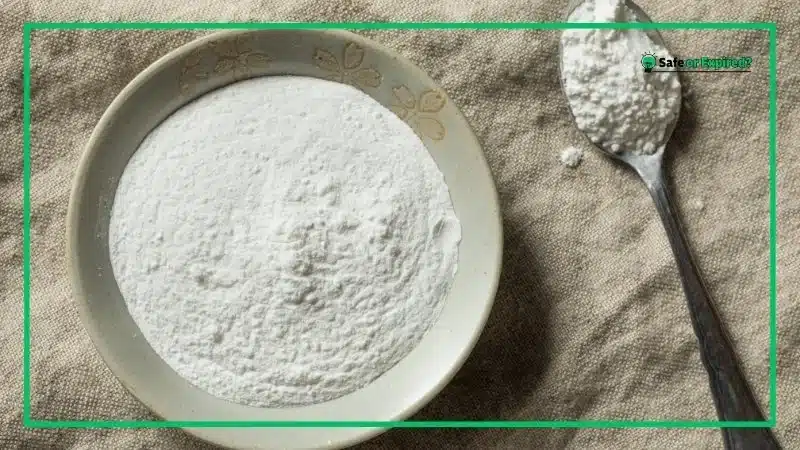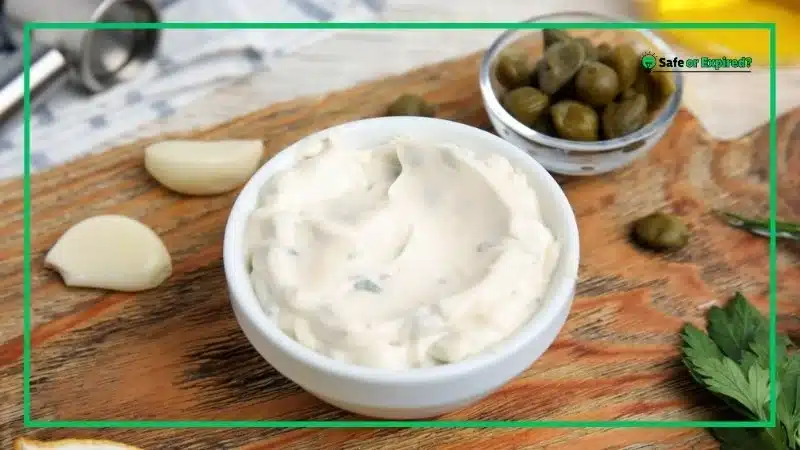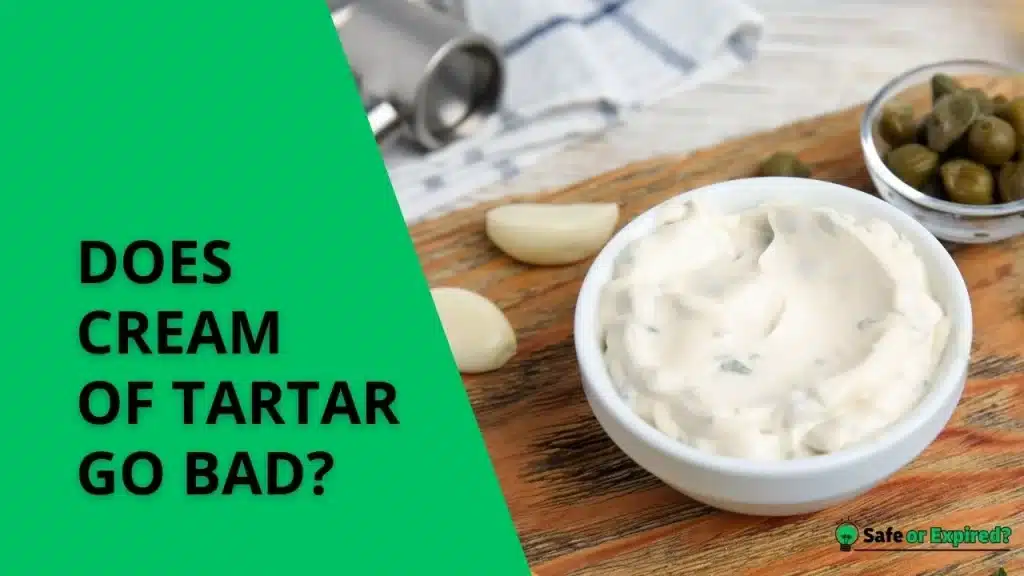“Does cream of tartar go bad?” is a dautning question for those keeping a well-stocked kitchen. Yes, it does go bad but it takes a long time. Worry not. Here, I’ll show you how to test it, what to do with expired cream of tartar, and some great alternatives.
Keep reading to make sure your baking turns out perfect every time!
Does Cream of Tartar Go Bad?
Yes, cream of tartar can go bad, but it takes a long time. Cream of tartar, a dry, powdered substance, remains stable for years if stored properly in a dry place. To test its potency, mix a small amount with baking soda and water; if it fizzes, it’s still good.
However, over time, it may lose its effectiveness, especially if exposed to moisture or heat.
Does Cream of Tartar Go Bad in the Fridge?
Cream of tartar doesn’t need to be refrigerated and can actually be negatively affected by the moisture in the fridge. Storing it in a cool place is best. The fridge’s humidity can cause the powder to clump and lose its potency faster.
It’s better to keep cream of tartar in a pantry or cupboard (to maintain its quality).
Does Unopened Cream of Tartar Go Bad?
Unopened cream of tartar can last for many years, often beyond the expiration date on the package. As long as it’s stored in a cool place and remains sealed, it should stay fresh and effective. The key is to keep it away from heat and moisture, which can degrade its quality over time.
Even after several years, unopened cream of tartar is likely still good to use.
How Long Does Cream of Tartar Go Bad?
Cream of tartar has an incredibly long shelf life and can remain good for years if stored properly. Typically, it doesn’t spoil but can lose potency over time. To ensure its effectiveness, store it in a dry place in an airtight container.
If you want to check if it’s still good, mix a bit with baking soda and water; if it fizzes, it’s still potent.
How Long Does Cream of Tartar Last After Opening?

Once opened, cream of tartar can last for years, often up to 3-4 years or even longer, provided it’s stored in an airtight container in a dry place. Exposure to moisture and heat can reduce its effectiveness, so proper storage is crucial to maintaining its quality.
How Long Does Cream of Tartar Last After Expiration Date?
Cream of tartar can last well beyond its expiration date if stored correctly. While the printed expiration date is often conservative, the actual shelf life can extend several years past this date. As long as it’s kept dry and in an airtight container, it should remain effective for baking and other uses.
Check out this cream of tartar shelf-life table:
| Situation | Shelf Life |
| After the expiration date, stored properly | Several years |
| Opened | 3-4 years or longer |
| After expiration date, stored properly | Several years beyond |
| Stored in the fridge | Not recommended |
What Happens if Cream of Tartar Is Expired? The Side Effects
Expired cream of tartar can lose its potency, making it less effective in recipes. It might also clump due to moisture. While it’s not harmful to use, its performance in baking may be compromised. To check if it’s still good, mix it with baking soda and water; if it fizzes, it’s still effective.
Loses Its Punch
When the cream of tartar gets old, it can lose its strength. This means it might not work in your recipes as well. If you’re making a cake or cookies and they don’t rise like they should, your cream of tartar might be too old. This is because the powder helps to create bubbles in the batter, which makes baked goods fluffy.
If it’s lost its punch, those bubbles don’t form as well. So, you might end up with flat cookies or dense cakes. To keep your baked treats light and fluffy, make sure your cream of tartar is fresh.
Clumps and Lumps
If your cream of tartar has been sitting around for a long time, it can start to clump up. This happens because it absorbs moisture from the air. When it gets clumpy, it’s hard to measure the right amount for your recipes.
Plus, those clumps might not mix well into your dough or batter. Imagine trying to stir a lumpy powder into your cake mix—it’s just not going to blend smoothly.
So, make sure your cream of tartar should look like this:

Effect on Taste
Expired cream of tartar usually doesn’t make your food taste bad, but it can sometimes absorb smells from other things in your pantry. If it’s been sitting next to strong-smelling spices, it might pick up those odors. This can give your baked goods a slightly different taste.
Fresh cream of tartar is always best for the best-tasting treats. If you want your cakes and cookies to taste just right, use fresh ingredients.
How To Test If Cream of Tartar Is Still Good?
To test if cream of tartar is still good, mix 1/2 teaspoon of it with 1/2 cup of warm (or lukewarm) water and 1/4 teaspoon of baking soda. If the mixture fizzes, your cream of tartar is still effective. No fizz means it’s time to get a new jar.
Here’s a step-by-step test for the cream of tartar:
Step 1: Gather Your Ingredients
First, you need to get a few simple ingredients. You’ll need 1/2 teaspoon of the cream, 1/2 cup of warm water, and 1/4 teaspoon of baking soda. These are probably things you already have in your kitchen.
Step 2: Mix Cream of Tartar and Baking Soda
Take a small bowl and put in 1/2 teaspoon of cream of tartar. Then, add the 1/4 teaspoon of baking soda. These two ingredients will react together to show if the cream of tartar is still good.
Step 3: Add Warm Water
Now, pour 1/2 cup of warm water into the bowl with the cream of tartar and baking soda. Make sure the water is warm but not too hot, as this helps the reaction happen.
Step 4: Look for Fizzing
Watch the mixture closely. If it starts to fizz and bubble, your cream of tartar is still good and can be used in your recipes. The fizzing means it’s still active and will work well in your baking.
Step 5: No Fizz? Time for a New Jar
If you don’t see any fizzing or bubbling, your cream of tartar has lost its potency. This means it won’t work as well in your recipes, and it’s time to buy a new jar. Keeping your ingredients fresh ensures your baking turns out great every time.
What To Do With Expired Cream of Tartar? 5 Things
Expired cream of tartar can still be useful for non-baking purposes. Use it for cleaning, polishing metals, or even as a natural ant deterrent. It’s a handy ingredient for various household tasks even if it’s no longer good for baking.
Cleaning with Expired Cream of Tartar
You might not know this, but an expired cream of tartar is great for cleaning! You can mix it with a bit of water to make a paste. This paste works wonders on stubborn stains in your kitchen and bathroom.
For example, if you have burnt marks on your pots and pans, just spread the paste on the marks and let it sit for a while. Then, scrub it off, and the stains should come off too. It’s also good for cleaning rust off metals. Rub the paste on the rusty spots, let it sit, and then wipe it away.
Your metal items will look shiny and new again.
Polishing Metals with Expired Cream of Tartar
Another cool use for expired cream of tartar is polishing metals. If you have silverware or jewelry that’s lost its shine, you can use cream of tartar to bring back the sparkle. Mix a small amount with water to form a paste. Then, apply it to the metal item and rub it gently with a soft cloth.
You’ll see the tarnish disappear and the shine return. This works well for copper and brass items, too. So, don’t throw away that old cream of tartar. Use it to keep your metals looking bright and clean.
Natural Ant Deterrent
Did you know that cream of tartar can help keep ants away? It’s true! Ants don’t like the acidity of cream of tartar. Sprinkle a line of the powder where you see ants coming into your home. They won’t cross the line because they don’t like the texture and taste.
It’s a natural and safe way to keep ants out of your house. Plus, it’s a great way to use up expired cream of tartar instead of just throwing it away.
Freshening Up Your Laundry
You can even use an expired cream of tartar to freshen up your laundry. Add a teaspoon to your wash cycle along with your regular detergent. It’s like giving your laundry an extra boost without using harsh chemicals.
Removing Crayon Marks
If you have kids, you’ve probably dealt with crayon marks on your walls. Guess what? Expired cream of tartar can help with that, too! Mix it with a little water to make a paste, then gently rub it on the crayon marks. The marks should come off easily without damaging the paint.
It’s a simple and effective way to clean up those artistic masterpieces on your walls.
Health Risks of Using Expired Cream of Tartar
Using expired cream of tartar is generally safe as it doesn’t spoil, but it can lose potency and effectiveness in recipes. There are no significant health risks if consumed, but always check for unusual odors or clumps that might indicate contamination.
No Major Health Risks
Expired cream of tartar doesn’t pose major health risks because it’s a dry, stable substance. Unlike fresh foods that can spoil and harbor harmful bacteria, cream of tartar doesn’t go bad in the same way.
So, if you accidentally use an expired cream of tartar in a recipe, you won’t get sick. It might just not work as well in your baking. This makes it much safer compared to other expired foods.
However, it’s always good to be cautious and check for any signs of contamination like strange smells or unusual clumps.
Loss of Potency
The biggest issue with using expired cream of tartar is that it loses its effectiveness over time. This means it might not help your baked goods rise as they should. If your cakes, cookies, or meringues don’t turn out right, the expired cream of tartar could be the culprit.
Fresh cream of tartar helps create the right texture and volume in your baking. When it’s expired, you lose that benefit, and your recipes might not come out as expected. So, while it’s safe to use, it’s better to have fresh cream of tartar for the best results.
Contamination Concerns
Though rare, there’s a slight chance that expired cream of tartar could get contaminated if it’s not stored properly. If it’s been exposed to moisture, it can clump and possibly develop mold. This isn’t common, but it’s something to be aware of.
Always store your cream of tartar in a dry, airtight container to avoid this issue. If you see any signs of spoilage or contamination, like mold or a strange odor, it’s best to throw it out and get a new jar. This way, you ensure you’re only using safe ingredients in your cooking and baking.
Changes in Flavor
Using expired cream of tartar might not change the taste of your food significantly, but there’s a slight chance it could affect the flavor. If the cream of tartar has absorbed odors from your pantry, it could alter the taste of your recipes.
This is another reason to store it properly and keep it sealed. While it’s not a health risk, you want your food to taste its best. Fresh cream of tartar helps ensure your baked goods have the right flavor.
How to Properly Dispose of Expired Cream of Tartar?
Disposing of expired cream of tartar is simple and safe. Since it’s a non-toxic, biodegradable substance, you can throw it in the trash or compost it. If you prefer, you can also clean it before discarding it.
The easiest way to get rid of expired cream of tartar is to throw it in the trash. Since it’s non-toxic and safe for the environment, you don’t have to worry about it causing harm. Just put the expired cream of tartar in a sealed bag and toss it into your regular trash bin.
This method is straightforward and ensures the powder doesn’t spill everywhere.
Alternatives to Cream of Tartar: What You Can Use Instead
If you’ve run out of cream of tartar or it’s expired, don’t worry! There are several great alternatives you can use in your recipes. Here’s what you can try:
Lemon Juice
Lemon juice is a fantastic substitute for cream of tartar. It’s acidic, just like cream of tartar, which means it can help stabilize egg whites and act as a leavening agent in baking. To substitute, use twice the amount of lemon juice.
For example, if a recipe calls for one teaspoon of cream of tartar, I suggest you to use two teaspoons of lemon juice. This alternative works well in meringues, cakes, and cookies. Plus, it adds a slight lemony flavor, which can be a nice touch.
Vinegar
White vinegar is another good alternative. It’s also acidic and can perform similar functions to the cream of tartar in recipes. Use the same amount of vinegar as you would cream of tartar. So, if your recipe needs one teaspoon of tartar cream, substitute it with one teaspoon of vinegar.
This works particularly well in baked goods and frostings. Just remember that vinegar has a stronger flavor than cream of tartar, so it’s best used in recipes where the taste will be masked by other ingredients.
Buttermilk
Buttermilk is slightly acidic and can be used as a substitute in recipes where cream of tartar is used for leavening. If your recipe requires cream of tartar and liquid, you can replace part of the liquid with buttermilk.
For example, if a recipe calls for one teaspoon of cream of tartar and 1 cup of milk, you should only use 1 cup of buttermilk instead. This works well in pancakes, muffins, and quick breads. Just be sure to reduce the other liquid in your recipe by the same amount of buttermilk you add.
Yogurt
Plain yogurt is another good alternative, especially in recipes where you need an acidic ingredient. Like with buttermilk, you can use yogurt to replace some of the liquid in your recipe. Mix the yogurt with a bit of milk to thin it out if needed.
This substitution is great for baking cakes, muffins, and breads. Use the same amount of yogurt as you would cream of tartar, and adjust the liquid in your recipe accordingly.
Conclusion
In this article, we’ve covered everything you need to know about cream of tartar:
- Cream of tartar can lose potency over time but is safe to use.
- Testing its freshness is easy with a simple fizz test.
- You can use expired tartar cream for cleaning and other household tasks.
- There are many alternatives, like lemon juice, vinegar, and baking powder.
- Proper storage keeps cream of tartar effective for longer.
Now, you can make sure your recipes always turn out great!

